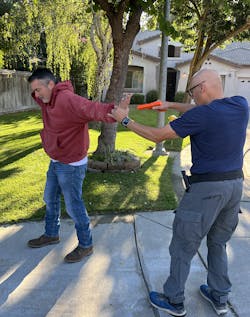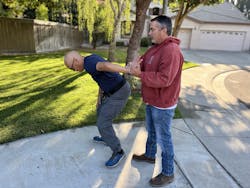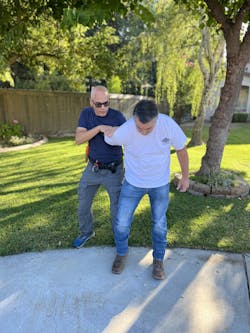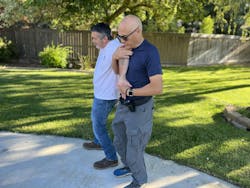Handcuffing: The Transition From Firearm to Cuffing a Suspect
This month we are looking at handcuffing, or more appropriately, the transition from the firearm to handcuffing a suspect. I’m certain that the first question that manifests is, “Why are we talking about handcuffing in a firearms tactics column?” The answer is simple. Holstering and handcuffing is a transition that can be exploited by a suspect, with dire consequences.
The purpose of this article is to discuss and offer guidelines for handcuffing training. The guidelines can only be general, but they should be helpful to any Officer. I’m always delighted to bunkai (analyze techniques by breaking them down) with anyone, and if you can catch me face-to-face, we can have some serious conversations about martial arts techniques. I have solicited my friend and training partner George Rivera, who has taught, competed, trained, and achieved mastery in more styles than he would allow me to list here. He is well respected in the martial arts community and is a lifelong student.
In your agency’s range training routine, there are several skills that should be routinely practiced that are not necessarily shooting skills. Range sessions should include things like clearing strikes and verbal command practice. I regularly add fitness skills to shooting. Handcuffing and defensive tactics are a natural addition. All of these skills must have de-escalation, ethical decision making, and scenario based role playing interspersed in the requirements. Monitoring progress and documenting results complete the litigation resistant package. The purpose of this training should not be aimed toward liability. Solid transitions from holstering to handcuffing will keep you alive.
Statistically, incidents of offenders going from semi- compliant, to violent is relatively low, according to statistics on Offer assaults. However, assaults on Officers have been on the rise, including a big jump from 2019 to 2020, where 60,105 Officers were assaulted. Most of the assaults came from Officers responding to disturbance calls. Nearly a third of all assaults on Officers in 2020 resulted in a reportable injury to the Officer.
Unfortunately, the most significant statistical increase in Officer assaults in the US has been ambush attacks, which increased 91% from 2020 to 2021. Assault during handcuffing or a handcuff transition is not as common, but there is enough anecdotal evidence to suggest that we need to train for it. The other anecdotal evidence that bears mention is the fact that recruits regularly report that they could have used “a little more arrest and control training” in academy. Although it is hard to quantify how much is enough, when it comes to training for perishable skills, the formula should always be “N+1”.
While I cannot provide you specific training in effective techniques-even Daniel LaRusso couldn’t learn karate from a book-we can address specific guidelines of transitioning from firearm to handcuffing.
Techniques should not be taught outside of their system
Police academies teach several handcuffing techniques, typically jujitsu or aikido style locks that are extracted from systems. In my academy days, we used a modified wrist lock that had a “if this doesn’t work” type of takedown, in case the wrist lock failed. Recruits are taught the basics of the lock, and the basics of handcuffing.
One technique commonly used is one which the suspect is ordered to face away from the Officer, extend the arms from the body parallel to the ground, and show the palms to the officer, thumbs pointing toward the ground. There are variations, including having the suspect bend forward, palms up, as if diving off a diving board.
The officer grasps the wrist, or places their palm in the suspects palm, palm -to-palm, rotating the suspects hand so it faces forward.
While the Officer grasps the hand or wrist, he holsters the gun, or secures the TASER, etc, out of the view of the suspect.
If there is a struggle, the Officer grasps the arm with the other hand, and drives the suspect to the ground.
Here’s the problem with this: Inside the martial arts system in which I train, I would flow into another lock without ever losing contact or control, or “stimulate” the tricep tendon, depending on the lock I used. I would not go to the ground. A Brazilian Jujitsu practitioner would most likely go to the ground. An Aikido practitioner would likely flow into a throw (for Aikido artists, the wrist lock technique faintly resembles SANKYO).
No technique is better than another if it is integrated into a vetted system. For example, in my shooting system, I do not make a distinction between an emergency reload and a speed reload. I use the same routine for an empty gun as I do for a gun with an unknown number of rounds. I have a friend who teaches shooting until slide lock, then reloading. Who is more correct? We both are, within our own systems.
There are two things you need for this training, and both of them come from ASP (asp-usa.com). One is a Red Gun, which is a replica forearm used for training. The other is a set of ASP Ultra Cuffs. These are handcuffs that look and act like real cuffs, but they disengage with a roll of the subject’s wrists. These are top of the line when it comes to realistic training, and I use them a lot.
Learn to take advantage of timing
George Rivera explained to me that the concept of divided attention, or, in martial arts terms, “two energies at the same time” is appropriate for handcuffing and defensive tactics. The simplest application of this concept is to ask the suspect a question, then move while he is talking. That is, hold the suspect at gunpoint and ask their name when holstering. The moment they begin to open their mouth, apply an immobilizing lock and holster the firearm at the same time.
Offenders use this concept also, and you need to be aware of it. Some violent offenders plan for Law Enforcement encounters and comply to a certain point, and then make their move. There have been instances where an Officer gets the first handcuff on, and the offender makes his move at this moment. This is, after all, a time when the Officer is within “hands on” distance, and likely has relaxed his guard because the first cuff is already on. The Officer’s hands are busy, and attention is on the handcuffing.
Without an immobilizing lock, the Officer’s divided attention is now turned toward the handcuffs themselves. It’s embarrassing to lose cuffs. They are often personal property, and most Officers consider them safety or protective items. This divided attention is the time when a suspect will either strike, or run, or both.
The way to mitigate the disaster that follows is to train with solid techniques that disorient the offender, take away their balance, and emphasize the locking technique, and not the handcuffs themselves. If the offender is off balance at the beginning of the encounter, then disregarding the handcuffed hand and forcing the suspect to use their hands to break their own fall will take away much of the surprise advantage.
Early in my martial arts career, under Professor Joe Souza, with whom I have trained for more than 3 decades, taught me to use the head to upset balance. We have some head takedowns that are legally defensible (they don’t have anything that cover the windpipe area and opponents can be lowered or propelled to the ground, depending on the situation). Agencies need to have similar tools in their toolbox.
Sometimes we use a distraction before applying a lock. It can amount to a slap on the body, or something similar.
Officers can use this for handcuffing too. After holstering and while initiating the lock, slap another part of the body, such as a shoulder or an upper arm, when applying the lock, then draw the handcuffs. It can be a gentle slap. The purpose is to divide attention.
Pain compliance techniques are only effective half the time
Several times in my career I have hit a suspect with a baton and the strike, although it did damage, was ineffective. The first time this happened, it took a microsecond for me to realize that pain was not this person’s language. We found out later in the hospital that he was moderately injured by the strike. He did not go “Ow!” or anything like that. He calmly told me that I should not have just done that, oblivious to any pain. The blow would have crumpled me.
Pain compliance holds work only on a limited population. Proper locks and control holds need to mechanically accomplish the desired goals without relying on pain control. A good control technique should include both pain compliance and mechanical control.
Distance is your friend
High risk handcuffing means that an Officer must go from soliciting compliance from a firearm or another device like the TASER to being within striking distance. There are some techniques that keep an Officer out range more than others. An extended wrist lock, where the Officer twists the suspects hand upwards, causing him to bend down, allows a little more distance, and therefore reaction time, might be a better choice than something like an arm bar, where the suspect may be closer to the Officer’s firearm.
The extended wrist uses a simple fulcrum and lever principle of bending the wrist up by applying pressure to the back of the hand. The body naturally attempts to relieve the pain pressure of this lock by bending forward, which takes the suspect’s solid, upright base away. Even if the suspect cannot register the pain of this lock, there is still the mechanical pressure of the bent arm. A smaller and lighter Officer can control a much larger person with this lock, if applied correctly.
From the extended wrist lock, the suspect can be put on the ground in several ways, including simply levering the wrist more, grinding the triceps tendon with the other forearm, or even kicking behind the suspects knee. The pressure can be applied while the gun is out, all the way through handcuffing.
Use verbal commands and disrupt balance in order to keep the non-controlled hand away from the body. For example, “Put your other hand on the back of your head.” If the suspect can touch his body, he can access weapons. With this lock, grinding the triceps tendon can put the suspect on his knees or limit movement.
I also like the extended wrist lock because it can be used to extract a person from a vehicle or a room.
Your training or your agency may have a different method for controlling a suspect when handcuffing. The important thing to know is why the technique works.
Sequence is important
One thing that a Law Enforcement Officer must learn early is that there are steps to controlling a person, and they must be performed in sequence in order to see the end of the shift. Do not modify the sequence of safety for political correctness, or for any other reason, actually. We train to handcuff, then search. These things must be done in sequence, and they are not independent of one another.
Unfortunately, the most dangerous practice in handcuffing is a lack of mindset. That is, a likely time of assault is when an Officer assumes that, just because the person is complying, or the charge is only a misdemeanor, or “I have one handcuff on…” If we were to look at many types of Officer assaults, which I do, by the way, we would find that many happen when the Officer has not used a decisive initial controlling force before doing anything else.
One thing that I teach is to have complete control before going from one technique to another. When it comes to handcuffing, this means understanding what is actually effective, and applying it correctly in sequence.
Train, train, train
High risk handcuffing is taught in Academy. I went to two different academies, one for Corrections, one for Patrol. In both iterations, there was an hourly defensive tactics requirement, and that was the limit of our handcuffing training. This is a perishable skill, and should be practiced almost daily. You may not be training on this regularly, but I guarantee that every Officer runs the risk of encountering someone who trains daily on how to counter an arrest. Get your Red Guns and Ultra Cuffs out and use them.
About the Author
Lindsey Bertomen is a retired police officer and retired military small arms trainer. He teaches criminal justice at Hartnell College in Salinas, California, where serves as a POST administrator and firearms instructor. He also teaches civilian firearms classes, enjoys fly fishing, martial arts, and mountain biking. His articles have appeared in print and online for over two decades.
About the Author

Officer Lindsey Bertomen (ret.), Contributing Editor
Lindsey Bertomen is a retired police officer and retired military small arms trainer. He teaches criminal justice at Hartnell College in Salinas, California, where serves as a POST administrator and firearms instructor. He also teaches civilian firearms classes, enjoys fly fishing, martial arts, and mountain biking. His articles have appeared in print and online for over two decades.




